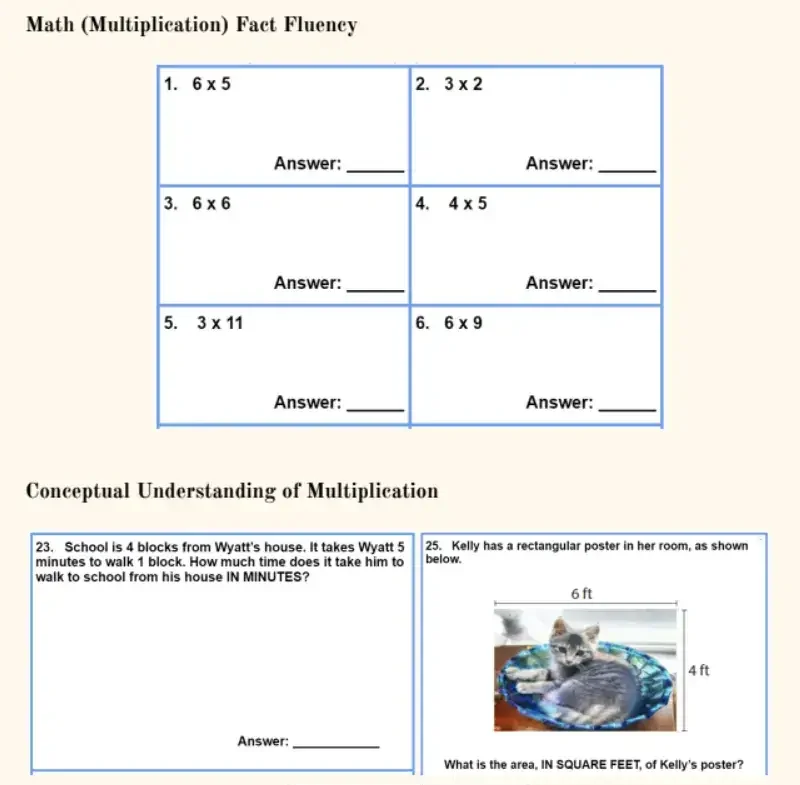The Mighty Multiplication Project Increases Fact Fluency

-
Nationwide Study
19 Schools Across 8 States
-
Third, Fourth, and Fifth Grade Classrooms
492 Students
27 Teachers
-
Pre and Post-Tests
Program Evaluation Tools
-
8 Weeks
Program Timeline
Study Focus: The impact of physical activity on multiplication fluency and math attitudes
The 2023 iteration of the Mighty Multiplication Project sought to study the effectiveness of kinesthetic learning strategies on students’ multiplication fluency and attitudes toward math. This iteration was informed by an earlier pilot project conducted by the National Math Foundation in partnership with Bridgewater College.
Over the course of 8 weeks, teachers used Math & Movement floor mats and activities to supplement their existing curriculum’s multiplication lessons. Students who participated in these kinesthetic activities demonstrated statistically significant improvement in math learning outcomes compared to students participating in traditional activities.
“Multiplication is a foundational mathematical skill and must be utilized in order to solve various higher order mathematical concepts,” the project overview by the National Math Foundation reads. “Adding physical movement to current teaching strategies bridges the gap for many struggling students and provides a new way for all students to become more engaged learners in the math classroom.”
Data Collection
-
Students completed a pre and post-test at the beginning and the end of the 8-week program to assess their multiplication fluency and changes in math attitudes. The test included 20 fact recall questions, 5 conceptual understanding questions, and 13 self-efficacy questions.
Sample questions in student pre and post-test.

Self-efficacy question in student pre and post-test.

-
Teachers completed a survey before and after the program to determine changes in their own attitudes toward teaching multiplication.
-
Teachers used an Activity Log to track the types of activities (kinesthetic or traditional) completed weekly with the class, the amount of time spent on each activity, and observed student engagement levels.

Challenges
-
The study had a relatively small sample size.
-
Students' previous knowledge of multiplication before the 8-week program varied.
-
Ultimately, teachers were expected to administer student pre and post-tests, use the Math & Movement materials to the best of their abilities during lessons, and record student interactions with the materials. Teacher bias may exist.
Solution
-
Math & Movement floor mats, including:
-
Math & Movement digital books and resources, including:
- Multiplication and Division in the Real World Book A (ebook)
- Math & Movement Training Manual (ebook)
- Oodles of Algebra (ebook)
- I Love to Cancel Workbook (ebook)
- Multiplication Marathon Workbooks (ebooks)
- Multiply With Me Instructors Guide and Workbook (ebooks)
- Digital Activity Guides and Lesson Plans
-
Project information guide, checklist, and project implementation guide for teachers

“This was a wonderful research project and I felt very excited and proud to be a part of it,” another participating teacher shared. “I will use the materials for years to come. My students require more than 8 weeks to master multiplication facts so I will extend the project. The data collection is a great resource for tracking progress.”
Results
-
Students who participated in kinesthetic activities demonstrated statistically significant improvement in math learning outcomes compared to those participating in traditional activities.
-
The researchers also found a correlation between the frequency of kinesthetic activities utilized and the extent of learning improvement. The more time spent on kinesthetic activities, the more multiplication fluency increased.
-
It is unclear if the math intervention program improved student math attitudes. There was a considerable shift in student self-efficacy scores from pre-intervention to post-invention, but not a statistically significant one.
-
Kinesthetic activities saw greater levels of student engagement compared to traditional activities. A highly significant relationship exists between the types of math activities and the level of student engagement.
-
Kinesthetic teaching strategies had some positive effects on teacher self-efficacy. The average score of teacher responses increased from pre to post-intervention surveys, but there was no significant statistical difference found across all questions.
-
There was a positive correlation between the average weekly time spent on kinesthetic activities and teacher self-efficacy scores. The more time that teachers spent doing kinesthetic activities, the higher they scored themselves on their ability to help students with multiplication and their own multiplication ability.
One teacher shared some comments from their students: “It was awesome!”, “Thank you for the project. It was so fun,” and “I really liked it. I wish we could do it ten more times.”
FREE DOWNLOAD
Mighty Multiplication Project Research Study
Enter your email to get a short two-page handout summarizing the results of the Mighty Multiplication Project from the National Math Foundation. Share the data with other teachers and administrators!

